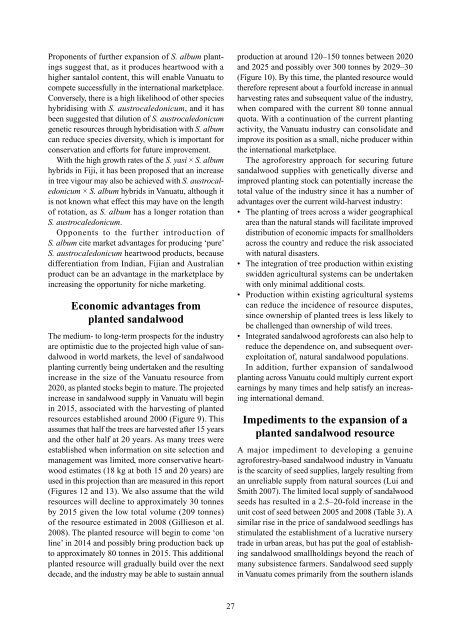Opportunities for the smallholder sandalwood industry in ... - ACIAR
Opportunities for the smallholder sandalwood industry in ... - ACIAR
Opportunities for the smallholder sandalwood industry in ... - ACIAR
You also want an ePaper? Increase the reach of your titles
YUMPU automatically turns print PDFs into web optimized ePapers that Google loves.
Proponents of fur<strong>the</strong>r expansion of S. album plant<strong>in</strong>gs<br />
suggest that, as it produces heartwood with a<br />
higher santalol content, this will enable Vanuatu to<br />
compete successfully <strong>in</strong> <strong>the</strong> <strong>in</strong>ternational marketplace.<br />
Conversely, <strong>the</strong>re is a high likelihood of o<strong>the</strong>r species<br />
hybridis<strong>in</strong>g with S. austrocaledonicum, and it has<br />
been suggested that dilution of S. austrocaledonicum<br />
genetic resources through hybridisation with S. album<br />
can reduce species diversity, which is important <strong>for</strong><br />
conservation and ef<strong>for</strong>ts <strong>for</strong> future improvement.<br />
With <strong>the</strong> high growth rates of <strong>the</strong> S. yasi × S. album<br />
hybrids <strong>in</strong> Fiji, it has been proposed that an <strong>in</strong>crease<br />
<strong>in</strong> tree vigour may also be achieved with S. austrocaledonicum<br />
× S. album hybrids <strong>in</strong> Vanuatu, although it<br />
is not known what effect this may have on <strong>the</strong> length<br />
of rotation, as S. album has a longer rotation than<br />
S. austrocaledonicum.<br />
Opponents to <strong>the</strong> fur<strong>the</strong>r <strong>in</strong>troduction of<br />
S. album cite market advantages <strong>for</strong> produc<strong>in</strong>g ‘pure’<br />
S. austrocaledonicum heartwood products, because<br />
differentiation from Indian, Fijian and Australian<br />
product can be an advantage <strong>in</strong> <strong>the</strong> marketplace by<br />
<strong>in</strong>creas<strong>in</strong>g <strong>the</strong> opportunity <strong>for</strong> niche market<strong>in</strong>g.<br />
Economic advantages from<br />
planted <strong>sandalwood</strong><br />
The medium- to long-term prospects <strong>for</strong> <strong>the</strong> <strong><strong>in</strong>dustry</strong><br />
are optimistic due to <strong>the</strong> projected high value of <strong>sandalwood</strong><br />
<strong>in</strong> world markets, <strong>the</strong> level of <strong>sandalwood</strong><br />
plant<strong>in</strong>g currently be<strong>in</strong>g undertaken and <strong>the</strong> result<strong>in</strong>g<br />
<strong>in</strong>crease <strong>in</strong> <strong>the</strong> size of <strong>the</strong> Vanuatu resource from<br />
2020, as planted stocks beg<strong>in</strong> to mature. The projected<br />
<strong>in</strong>crease <strong>in</strong> <strong>sandalwood</strong> supply <strong>in</strong> Vanuatu will beg<strong>in</strong><br />
<strong>in</strong> 2015, associated with <strong>the</strong> harvest<strong>in</strong>g of planted<br />
resources established around 2000 (Figure 9). This<br />
assumes that half <strong>the</strong> trees are harvested after 15 years<br />
and <strong>the</strong> o<strong>the</strong>r half at 20 years. As many trees were<br />
established when <strong>in</strong><strong>for</strong>mation on site selection and<br />
management was limited, more conservative heartwood<br />
estimates (18 kg at both 15 and 20 years) are<br />
used <strong>in</strong> this projection than are measured <strong>in</strong> this report<br />
(Figures 12 and 13). We also assume that <strong>the</strong> wild<br />
resources will decl<strong>in</strong>e to approximately 30 tonnes<br />
by 2015 given <strong>the</strong> low total volume (209 tonnes)<br />
of <strong>the</strong> resource estimated <strong>in</strong> 2008 (Gillieson et al.<br />
2008). The planted resource will beg<strong>in</strong> to come ‘on<br />
l<strong>in</strong>e’ <strong>in</strong> 2014 and possibly br<strong>in</strong>g production back up<br />
to approximately 80 tonnes <strong>in</strong> 2015. This additional<br />
planted resource will gradually build over <strong>the</strong> next<br />
decade, and <strong>the</strong> <strong><strong>in</strong>dustry</strong> may be able to susta<strong>in</strong> annual<br />
production at around 120–150 tonnes between 2020<br />
and 2025 and possibly over 300 tonnes by 2029–30<br />
(Figure 10). By this time, <strong>the</strong> planted resource would<br />
<strong>the</strong>re<strong>for</strong>e represent about a fourfold <strong>in</strong>crease <strong>in</strong> annual<br />
harvest<strong>in</strong>g rates and subsequent value of <strong>the</strong> <strong><strong>in</strong>dustry</strong>,<br />
when compared with <strong>the</strong> current 80 tonne annual<br />
quota. With a cont<strong>in</strong>uation of <strong>the</strong> current plant<strong>in</strong>g<br />
activity, <strong>the</strong> Vanuatu <strong><strong>in</strong>dustry</strong> can consolidate and<br />
improve its position as a small, niche producer with<strong>in</strong><br />
<strong>the</strong> <strong>in</strong>ternational marketplace.<br />
The agro<strong>for</strong>estry approach <strong>for</strong> secur<strong>in</strong>g future<br />
<strong>sandalwood</strong> supplies with genetically diverse and<br />
improved plant<strong>in</strong>g stock can potentially <strong>in</strong>crease <strong>the</strong><br />
total value of <strong>the</strong> <strong><strong>in</strong>dustry</strong> s<strong>in</strong>ce it has a number of<br />
advantages over <strong>the</strong> current wild-harvest <strong><strong>in</strong>dustry</strong>:<br />
• The plant<strong>in</strong>g of trees across a wider geographical<br />
area than <strong>the</strong> natural stands will facilitate improved<br />
distribution of economic impacts <strong>for</strong> <strong>smallholder</strong>s<br />
across <strong>the</strong> country and reduce <strong>the</strong> risk associated<br />
with natural disasters.<br />
• The <strong>in</strong>tegration of tree production with<strong>in</strong> exist<strong>in</strong>g<br />
swidden agricultural systems can be undertaken<br />
with only m<strong>in</strong>imal additional costs.<br />
• Production with<strong>in</strong> exist<strong>in</strong>g agricultural systems<br />
can reduce <strong>the</strong> <strong>in</strong>cidence of resource disputes,<br />
s<strong>in</strong>ce ownership of planted trees is less likely to<br />
be challenged than ownership of wild trees.<br />
• Integrated <strong>sandalwood</strong> agro<strong>for</strong>ests can also help to<br />
reduce <strong>the</strong> dependence on, and subsequent overexploitation<br />
of, natural <strong>sandalwood</strong> populations.<br />
In addition, fur<strong>the</strong>r expansion of <strong>sandalwood</strong><br />
plant<strong>in</strong>g across Vanuatu could multiply current export<br />
earn<strong>in</strong>gs by many times and help satisfy an <strong>in</strong>creas<strong>in</strong>g<br />
<strong>in</strong>ternational demand.<br />
Impediments to <strong>the</strong> expansion of a<br />
planted <strong>sandalwood</strong> resource<br />
A major impediment to develop<strong>in</strong>g a genu<strong>in</strong>e<br />
agro<strong>for</strong>estry-based <strong>sandalwood</strong> <strong><strong>in</strong>dustry</strong> <strong>in</strong> Vanuatu<br />
is <strong>the</strong> scarcity of seed supplies, largely result<strong>in</strong>g from<br />
an unreliable supply from natural sources (Lui and<br />
Smith 2007). The limited local supply of <strong>sandalwood</strong><br />
seeds has resulted <strong>in</strong> a 2.5–20-fold <strong>in</strong>crease <strong>in</strong> <strong>the</strong><br />
unit cost of seed between 2005 and 2008 (Table 3). A<br />
similar rise <strong>in</strong> <strong>the</strong> price of <strong>sandalwood</strong> seedl<strong>in</strong>gs has<br />
stimulated <strong>the</strong> establishment of a lucrative nursery<br />
trade <strong>in</strong> urban areas, but has put <strong>the</strong> goal of establish<strong>in</strong>g<br />
<strong>sandalwood</strong> smallhold<strong>in</strong>gs beyond <strong>the</strong> reach of<br />
many subsistence farmers. Sandalwood seed supply<br />
<strong>in</strong> Vanuatu comes primarily from <strong>the</strong> sou<strong>the</strong>rn islands<br />
27
















